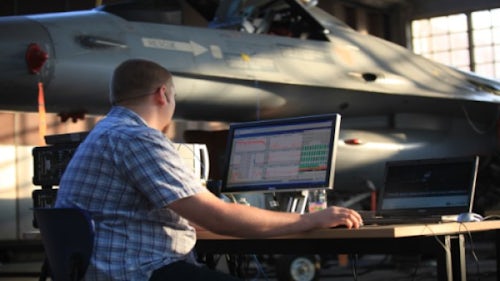Accelerate airworthiness certification with efficient aircraft ground vibration testing (GVT)
Aircraft ground vibration testing (GVT) is a major milestone in the airworthiness certification process. A GVT delivers experimental vibration data for the entire aircraft structure in order to validate and improve its structural dynamic models. Models are used to predict flutter behavior and plan safety critical flight tests.
This white paper discusses several techniques to accelerate the airworthiness certification process while delivering extensive and insightful data in the shortest possible time. These techniques help engineers perform GVT more efficiently without compromising the accuracy of the results.
How to perform efficient aircraft ground vibration testing
Engineers under extremely tight deadlines, considering the limited aircraft availability, need to perform ground vibration tests that are faster, more efficient and deliver better insights into the aircraft behavior.
Are you struggling to meet the test requirements in time?
Read this white paper “Efficient aircraft ground vibration testing”, and you will learn:
- How to shrink test setup time by integrating your finite element (FE) model into the test preparation
- How to efficiently verify the test setup by using the appropriate hardware and software solutions
- How to take advantage of a full range of excitation signals to accelerate your measurements
- How to benefit from swift data processing and estimate your modal parameters faster and easier
- How to update the aircraft’s FE model in full confidence
How will the next-generation aircraft meet the challenges of airworthiness certification ?
To comply with stringent regulations for reduced emissions, aircraft manufacturers design and develop innovative aircraft architectures and lightweight structures that use composite materials. These new architectures and materials bring uncertainties around the aircraft structural dynamics performance. Electric propulsion systems offer further possibilities for disruptive vertical take-off and landing (VTOL) aircraft configurations and new urban air mobility concepts. These innovative designs increase the workload required to validate and tune their performance, while time constraints remain. Engineers are under pressure to meet program deadlines while lacking experience and data about the aircraft structural dynamics performance.
Simcenter bloggers confer with aviation expert Raphaël Hallez about “Will the next-generation aircraft meet the challenges of airworthiness certification?” Join the conversation!"
Insight on the trends in airworthiness certification regulations from an EASA expert
Back in 2018, at the Simcenter GVT Master Class, Siemens had the pleasure to host Mrs. Elena Garcia Sanchez, Structures Expert at the European Aviation Safety Agency (EASA). Mrs. Sanchez gave a presentation on how to comply with aeroelastic stability requirements and validate the aircraft structural dynamics performance.
Interested to learn more, read this “Trends in aircraft certification regulations: insights from an EASA expert” on the Simcenter blog.
Explore a wealth of solutions for characterizing the aircraft structural dynamics
Beyond GVT, Simcenter offers a scale of solutions for efficient aircraft structural dynamics testing. Simcenter Testing Solutions eliminate the need for extensive trial-and-error testing and time-consuming setups. They help you focus on the problem’s root cause using state-of-the-art modal parameter identification methods and straightforwardly identify the optimal solution to address structural weaknesses.
From simple impact testing to large-scale modal surveys, structural dynamics testing helps you solve a wide range of vibration issues. Explore the breadth of the Simcenter state-of-the-art solutions at Simcenter for structural dynamics testing.
Learn the theory behind aircraft ground vibration testing and flutter analysis
Not familiar with the topics described in the white paper? Start at the beginning and read the knowledge-based article: Aircraft ground vibration testing and flutter analysis. This article will get you covered on the basics and will leave you eager to learn more!
